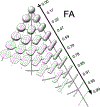Advanced neuroimaging applied to veterans and service personnel with traumatic brain injury: state of the art and potential benefits
- PMID: 26350144
- PMCID: PMC6547383
- DOI: 10.1007/s11682-015-9444-y
Advanced neuroimaging applied to veterans and service personnel with traumatic brain injury: state of the art and potential benefits
Abstract
Traumatic brain injury (TBI) remains one of the most prevalent forms of morbidity among Veterans and Service Members, particularly for those engaged in the conflicts in Iraq and Afghanistan. Neuroimaging has been considered a potentially useful diagnostic and prognostic tool across the spectrum of TBI generally, but may have particular importance in military populations where the diagnosis of mild TBI is particularly challenging, given the frequent lack of documentation on the nature of the injuries and mixed etiologies, and highly comorbid with other disorders such as post-traumatic stress disorder, depression, and substance misuse. Imaging has also been employed in attempts to understand better the potential late effects of trauma and to evaluate the effects of promising therapeutic interventions. This review surveys the use of structural and functional neuroimaging techniques utilized in military studies published to date, including the utilization of quantitative fluid attenuated inversion recovery (FLAIR), susceptibility weighted imaging (SWI), volumetric analysis, diffusion tensor imaging (DTI), magnetization transfer imaging (MTI), positron emission tomography (PET), magnetoencephalography (MEG), task-based and resting state functional MRI (fMRI), arterial spin labeling (ASL), and magnetic resonance spectroscopy (MRS). The importance of quality assurance testing in current and future research is also highlighted. Current challenges and limitations of each technique are outlined, and future directions are discussed.
Keywords: Diffusion tensor imaging; Magnetic resonance imaging; Magnetic resonance spectroscopy; Positron emission tomography; Traumatic brain injury; Veteran; fMRI.
Conflict of interest statement
Figures






References
-
- Alsop DC, Detre JA, Golay X, Gunther M, Hendrikse J, Hernandez-Garcia L, et al. (2014). Recommended implementation of arterial spin-labeled perfusion MRI for clinical applications: a consensus of the ISMRM perfusion study group and the European consortium for ASL in dementia. Magnetic Resonance in Medicine. doi:10.1002/mrm.25197. - DOI - PMC - PubMed
-
- Amann M, Sprenger T, Naegelin Y, Reinhardt J, Kuster P, Hirsch JG, et al. (2015). Comparison between balanced steady-state free precession and standard spoiled gradient echo magnetization transfer ratio imaging in multiple sclerosis: methodical and clinical considerations. Neuroimage, 108, 87–94. doi:10.1016/j.neuroimage.2014.12.045. - DOI - PubMed
Publication types
MeSH terms
Grants and funding
LinkOut - more resources
Full Text Sources
Other Literature Sources
Medical

